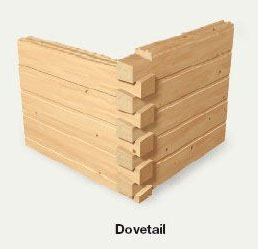Our Logs
We only use the best lumber and patented (US Patent 3791430) triple tongue and groove log construction used only by Louisiana Log Home. Pride yourself in know that your home is built with only the best.
Log Profiles
We offer a wide variety of log profiles!

Solid Round Beams
The staple to almost any log home is the solid round beam. This comes in 4″ up to 16″ cross sections up to 40′ in length.

Round Tongue & Groove
The traditional round log but with the modifier… the logs have a tongue and groove to hold them in place. This comes in 6″x8″ and 8″x8″ cross sections up to 40′.

D-Shaped Tongue & Grove
Featuring our patented tongue and groove system with one side flat and the other rounded forming an iconic D Shape. This comes in 7.25″x10″ cross section up to 40′.

Clap Board Tongue & Groove
Not a big fan of the round shape? This is for you then. Angled like tradition siding but still 100% log home featuring out Patented Tongue and Groove system as well! This comes in 6″x8″ and 8″x8″ cross sections up to 40′.

Square Tongue & Grove
Sometimes you just want the flat exterior look. 100% solid logs with two flat sides and featuring out patented tongue and groove channels! This comes in 6″x8″ and 8″x8″ cross sections up to 40′.

Log Siding
Log siding is a great way to get that log home look but keeping with the more traditional home construction. This comes in 3″x8″ and 3″x10″ cross sections up to 40′.
Log Corner Styles
Our log homes can be constructed with any number of corner styles! Take a look at the most common styles we use. Contact us if you have something else in mind

Swedish Cope
Swedish Cope logs are round on the inside and outside. The top is also left round. A half moon shaped groove is cut into the log along the bottom. This concave groove provides overlapping one log to the next when the log wall is stacked and gives this log style it’s name, Swedish Cope

Butt and Pass
The butt and pass style method of building cabins is a construction technique which uses tightly-pinned or oly Screwed corners, to remove the need for any notching, to join the logs together. The technique requires each log to be stacked on-top of another, at right angles, and then being pinned or fixed together.

Dovetail
The dovetail is one of many types of notches. It is superior to the others for one simple reason: In the event, any water makes it into the notch, the slope of the notch always directs the water straight away to the outside face of the log. Other notches can trap water within, which will lead to rot.
